
| SITUATION | PILLARS | EXCAVATION | IMBRICATED | GROOVED | RIPPLED | BOSSED | PLAIN | OTHER |
Notes on the Il Lokeridede Pillar Site
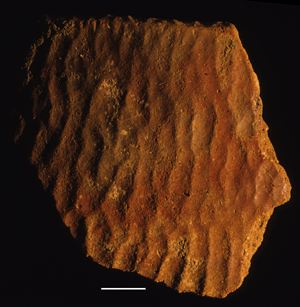
Ripple Decorated Ceramics at Il Lokeridede
white bar = 1 cm.
None of the sherds on this page have internal decoration.
A typical ripple motif vessel, with pigmented slip and ripple burnishing. The burnishing is done using a object with a smooth, rounded surface, such as the margin of a flat, well-rounded pebble. Such pebbles, with polished edges, have been found at the Jarigole Pillar Site.
The rippled surface mimics the ripples created by the wind on the surface of Lake Turkana and in the sands along its shore, and by waves washing over sand spits along the shore of the lake.


In this version of the Ripple motif, the burnishing proceeds in long, groove-like furrows. The potter moves across the face of the vessel extending each furrow a little at a time, propagating the field of furrows downward from the rim. This is done because the diameter of the vessel changes continuously as one moves from the rim to the base. To propagate the same number of furrows down the face of vessel, the width of each furrow much change. These adjustments are easy to make over short distances by impressing the burnishing implement slightly more or less, or tilting it a little to the side to increase the surface area that encounters the clay body.
This vessel was ripple burnished, gently coated with a pigmented slip, and then over burnished in a 2 cm. band below the rim, so that the furrows appear gradually as they move away from the rim.

This rim sherd looks as though it could come from the same vessel as the sherd pictured immediately above. However, the vessel profile, diameter and rim decoration are all different. In addition, the pigmented slip was added in such a way that the crest of each furrow was pulled to the right, creating the illusion of breaking waves that move from left to right over the surface of the vessel. There is more extensive burnishing at the rim, but it is only 1 cm. in width on this vessel.
The top three sherds on this page illustrate how Nderit potters could take the simplest of decorative techniques and elaborate it into different styles and expressions. Infinite recombination to achieve individual expression is one of the underlying themes of Nderit Ware.

The exterior and interior of a ripple motif sherd that has spent some time on the surface. This rim sherd exhibits interior and exterior rim facets decorated with imbricated stylus impressions made with the stylus oriented corner-on to produce this pattern of chevron-like steps. There are five impressions in each row, 2.6 rows per cm., a rim circumference is at least 90 cm., and both interior and exterior facets. Thus, we have 2.6 x 90 x 2 x 5 = 2,340 individual stylus impressions just to decorate the edges of the rim. Who said ripple burnishing was a decorative shortcut anyway?

Notice that the interior surface has a burnished pigmented slip speckled with white bits of shell. When included in the slip, the shell fragments are so close to the surface that they create enough gas during firing to pop off the slip surface, leaving white speckles on a red ground.
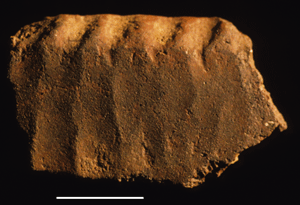
The rim was decorated first, with deep transverse cuts that were folded back. Then the evulsed ridges between the cuts were flattened. Following this, the vessel was covered with a brown-orange pig- mented slip. The flattened rim was burnished. Then it looks like the exterior of the vessel was ripple burnished, working the slip into the clay fabric in the process. |
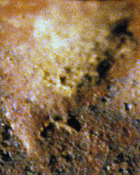
|
This left sharp ridges between the ripples. Also, if you look closely, you can see bits of the slip in pores and in suture-like structures, which may be the distorted folds left between coils of the clay body that were pulled down the face of the vessel in the process of ripple burnishing.
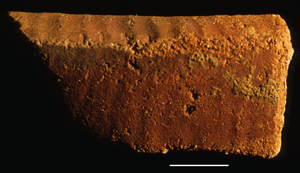
Ripple burnishing both on the rim and the body. The rim appears to have a thick, durable, unpigmented slip. The body, after over-burnishing, received a very thin coat of a paint designed to be fired. Such paints are known from Jarigole, where they were also used to enhance design elements.
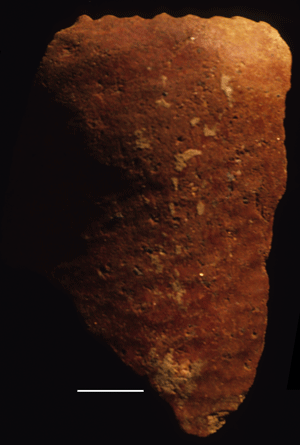
This is an unusual vessel. It is evidently a large jar with a long vertical neck or a beaker with a turned-in lip. The ripple burnishing is horizontal, roughly parallel to the rim, a mode of application that is extremely uncommon. After burnishing a red, pigmented slip was applied before firing.
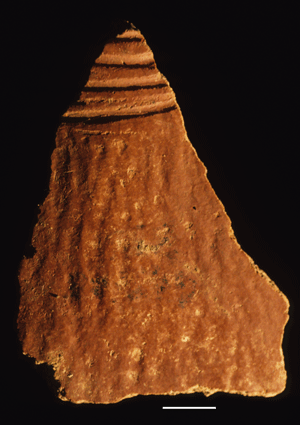
Highly burnished, red pigmented slip. The body exhibits classic burnished ripples that have then been heavily over-slipped and over-burnished. The neck of this large, closed jar has been decorated with deep grooves. The grooves were added after the the burnishing was complete and are crisply defined in comparison to the undulating surface of the lower neck and body.
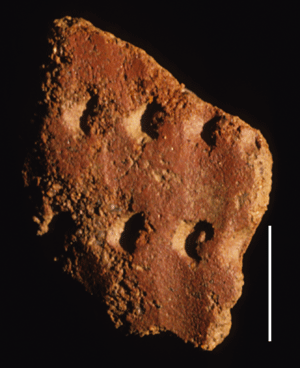
Burnished ripples, followed by a pigmented slip, followed by impressions using the base of a snail, probably of the species Melanoides tuberculata.

This ripple motif sherd has been heavily weathered while exposed on the surface. The rim exhibits a fine crosshatching. The hatch squares are crisp because the edge of a stylus was impressed to form the narrow grooves. If the grooves had been made by dragging, the squares would be pulled out at the corners.
All Il Lokeridede web pages on this site
© 2008 by Charles M. Nelson
all rights reserved